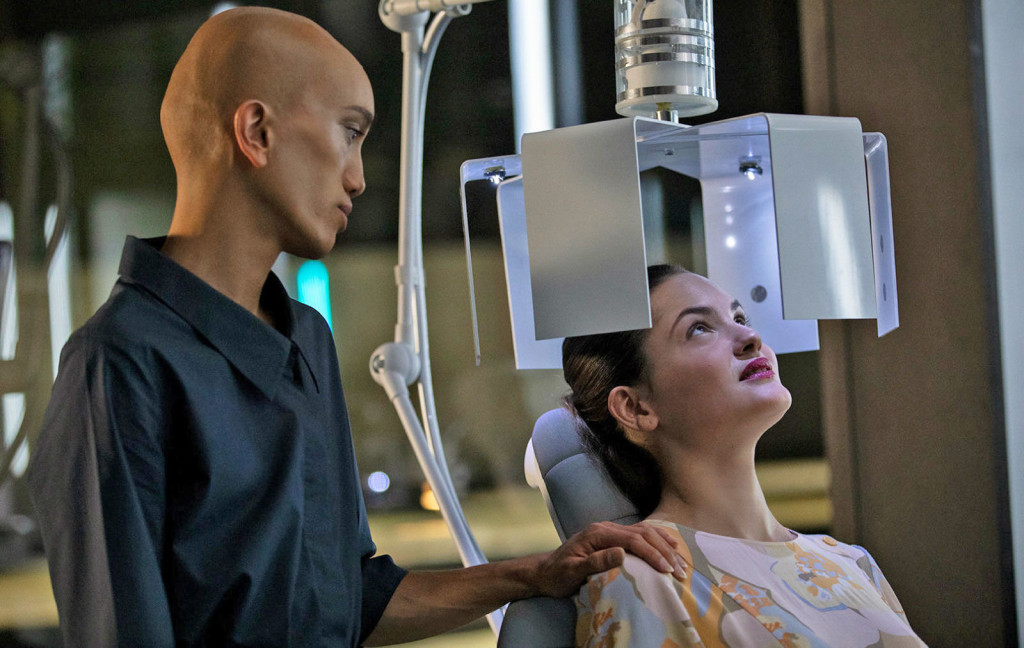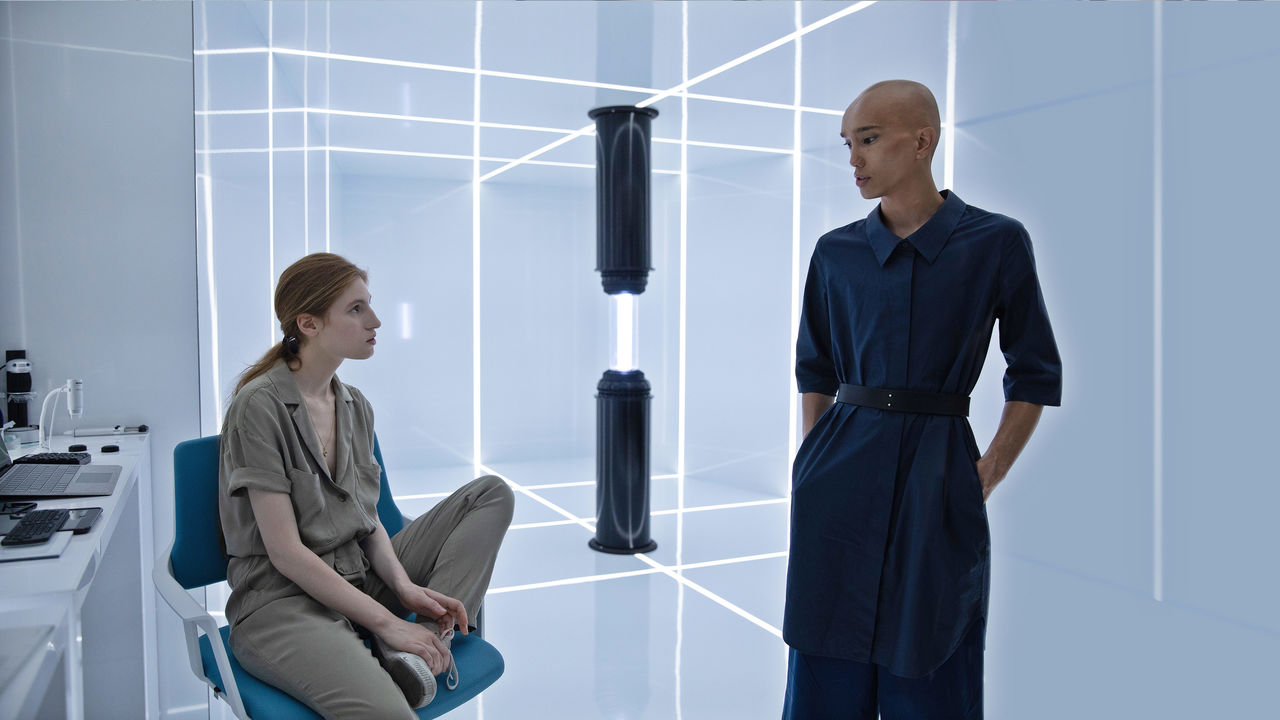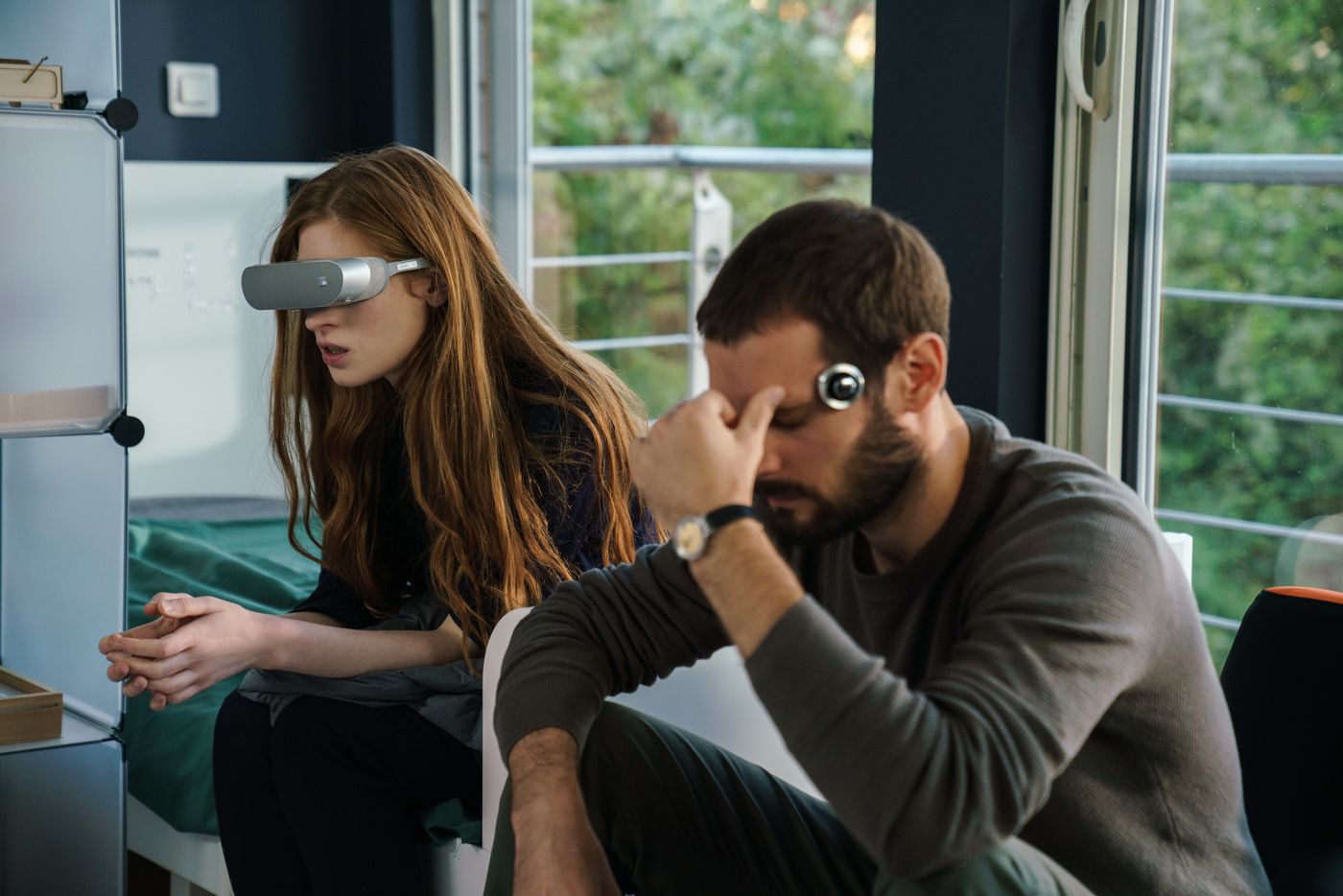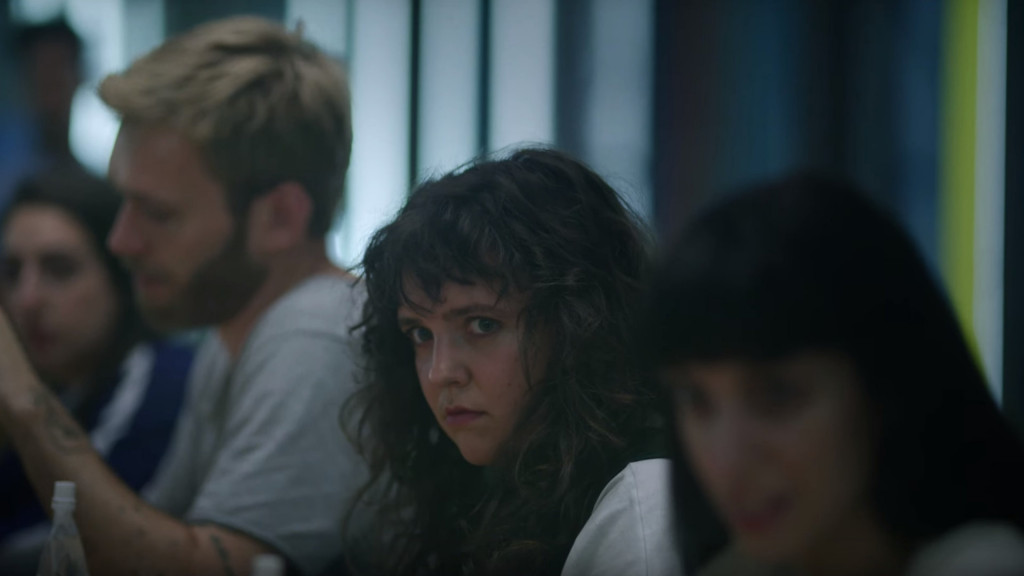The way Netflix is flooding its library with one sci-fi show after another, it seems as if the streaming service’s resolution for 2019 was to up their game in the genre! With the streak of films and TV shows that Netflix has delivered in a span of mere three months of the new year, at least one of us will not pile up their promises for the next year (again!). For the people who love the sci-fi genre, it is an absolute fest and ‘Osmosis’ is the latest treat. Everyone is calling it a French version, though a mild one, of ‘Black Mirror’, and trust me, after you’re done with it, you’ll use the same description to trick your friends into watching this show. If you haven’t spent your whole day binge-watching it, you might want to do that before moving forward into this article.
SPOILER ALERT!
Summary of the Plot

In a not so distant future, a genius brother-sister duo has devised a way to find people’s soulmates. They’ve been working on the tech for a couple of years, at least, and now, they’ve finally reached the beta testing phase. Here, twelve people are given the chance to enter the experiment and get a chance to come face to face with their one true love. The enthusiasm of the participants, their eagerness to go through with the plan seems rather obvious. I mean, if you had the chance of cutting to the chase and just finding the person who is best suited for you, and vice versa, wouldn’t you take it?
The answer might be simple (yes, of course). The consequences, on the other hand- not so much! The thing is, love has never been a simple act. It has always been complicated, and perhaps that is what made it so enticing. As one of the characters later says, “you forgot that with love also comes hurt”. The makers of this elaborate scheme don’t count in this aspect of the very thing they’re trying so hard to perfect. How can you solve a puzzle when one of the crucial pieces is missing? One single miscalculation and the whole plan falls apart.
What is Osmosis and How It Works?

Necessity is the mother of invention. For Esther, it wasn’t the need to find her soulmate that led her to the invention of the tech that would later develop into Osmosis. It was her love for her brother and her mother, the need to bring them back to life. “I already have two soulmates and they take up most of my time.” This is what she says when asked why she hasn’t made use of her invention herself. Her motivation never was to find anyone’s soulmate. Like many inventions before, it was just an unintended by-product of something else was intended.
Some years before the beta testing phase, Paul had been very sick. He had slipped into a vegetative state, from which there was no chance for him to come back. A dedicated Esther refused to accept this fate for her brother and came up with a technology that involved nanobots rewiring the brain functions to bring Paul back to life. It worked wonderfully, as instantly, Paul’s brain activity was enhanced and he gained consciousness.
However, something else happened too, something which Esther hadn’t anticipated. As Paul gained control of his sense, a picture materialised in front of his eyes. This picture was Josephine’s, someone he had never met before. But once he laid eyes on her, he knew she was his soulmate. When Josephine reciprocated his love, she was given a transplant like Paul, and because Paul was her soulmate, a connection developed between them which allowed them to connect with each other, even if they were to be on the opposite ends of the world. Hence, the idea of finding a soulmate was incepted.

Over the years, Esther, Paul and their team, which mostly constituted of people they had all their lives, perfected the tech and created an elaborate system through which anyone could find their soulmate. An AI called Martin was created by Esther, which was so dear to her that no one else was allowed around him.
The process would be this: a person would ingest a capsule that would release nanobots in their body. These nanobots would explore the deepest and darkest parts of your brain, especially the subconscious, and send the data to Martin, who would then run a check over the millions of profiles available online and filter down them to just one person- this would be your designated soulmate. Of course, since the tech was still in the testing phase, there could be some glitches, no matter how minor, and there’d be a margin for error.
Once you had the face of your soulmate, Martin would identify them for you and even lead you to them. You’d have the chance to connect to them, either by telling them the truth about the experiment, or simply making it look like you had met by chance. Once your soulmate would be ready to have the implant of their own, the two of you would share a connection that will have an on/off switch on your wrist. No matter how far apart you’d be, all you’ll have to do is activate your connection and you’d be able to share an intimate moment with your partner in a place that seems like a void and is called V-eternity. This would be your own personal space, without any interruptions from the outside world. Welcome to your happily ever after!
Esther and the Case of False Memories

While everyone was trying out their luck at finding their one true love, there was one person who didn’t care about any of this charade. Ironically, it was the very person who had invented this crazy technology. Esther’s motivation was to heal her brother and when she succeeded at it, she decided to use it to help her mother. Just as Paul had fallen into a coma, their mother- Louise- seemed to have the same condition; the cause, however, seemed to differ. Alzheimer’s seemed to be the cause of her affliction.
Having once succeeded at making the impossible happen, Esther decided not to give up on her mother, much to the chagrin of her brother, who wanted her to direct all her energy towards the Osmosis project. At first, Paul appears to be an inconsiderate son. How can he not want to make her mother just as she was before? After some time, we get a hint that his relationship with their mother hadn’t been so good and that there was a secret that he was hiding from Esther, something that would break her. This secret was that Esther was not his biological sister.
Paul’s real sister had died at a very young age, by hitting her head and drowning in the swimming pool. To fill the void left behind by her daughter’s absence, Louise adopted a young girl and conditioned her to believe that she was her real daughter. She moulded the young girl’s mind by constantly showing her pictures of her real daughter and telling her stories, demanding a backing from Paul, so the girl grew up with the memories that were fed to her and she believed herself to be Paul’s real sister.
One of the memories that Louise constantly fed the new-Esther was the swimming pool event. She told her that as children, they’d play games where Esther would pretend to drown and Paul would come to save her. It seems like the main purpose of this action was for Louise to condition herself to believe this, to believe that her daughter hadn’t died that day and the girl sitting in front of her was actually Esther. This was the memory that Esther grew up with and considered it the most important memory for her family.

In the present time, Esther chose the swimming pool memory to be implanted in her mother’s brain, believing that it would trigger something in her mind and might bring her back. She tried a great number of times but Louise’s mind always rejected it. At that time, Esther believed it to be because of the insufficiency of her tech. So, she tried to use some other way, getting the calculations right to attempt it again. The true anomaly in the plan was the memory itself. Esther had been trying to implant the memory that she believed happened. However, it wasn’t the same for Louise, so her brain refused to accept it.
With access to the brain functions of the beta testers, Esther came up with a plan to save her mother. Since a single person’s brain function wouldn’t be the exact match for her mother’s, she combined the functions of three different people. Then, she forced her memory inside their brain, which would then be transplanted to her mother because of the matching of the brain functions. Or at least, this is what she had imagined would happen. It, sort of, worked, as Louise did gain consciousness.
However, she didn’t remember Esther. In the last attempt to make her remember, Esther took Louise to their old house, and once they were at the pool, Esther’s memories triggered and she remembered the events exactly as they had happened. This is when the truth was revealed to Esther. This is when we discover that Paul had spent the better part of his life living with the guilt of his sister’s death and being continuously tormented by his mother to accept the new girl. This torment made him despise her, and that’s why he wasn’t so enthusiastic about treating her.
In the end, he was right. Once Louise was back to her old self, the pain of losing her daughter returned and she demanded to be put out of her misery.
The Side Effects of Finding Your Soulmate

Expecting humans to have 100% pure motivation behind loving someone would be a foolish thought. We aren’t so simple and neither are the reasons behind anything we ever do. This is why we always find ourselves at crossroads when it comes to making some big decisions in our lives. It is often said, “deep down, you know what you really want.” And maybe that’s true. But honestly, that coveted “deep down” is so down under that we never reach it. In the end, we just need someone else to confirm our decisions for us. Hence, the practice of asking for advice! Through its character, ‘Osmosis’ reinstates this fact in a very efficient manner.
Everyone’s reason for finding their soulmate is embedded in something that they want someone else to confirm for them. And what could be better than a master tech that studies our brain inside out to tell us what we really want? How could an artificial intelligence possibly be wrong about the most important decision of our life?
Let’s start with Paul. He is the first person to receive the implant, and he is the first one to get a soulmate as a bonus with another chance at a normal and functioning life. Why does Paul need this tech? All his life, Paul has been so much pestered by his mother that the idea of loving someone has become a distorted dream in his life. He is passionate and dedicated to his work. From the looks of it, he has really given his all and is ready to give the remaining to make Osmosis work. We don’t have an idea of his love life before Josephine, but I’m guessing it wasn’t so good. Obviously, Paul didn’t want to be alone, but there was something else he valued more than love- control. From the first episode, we see how he always wants to be on the top of things. He loses his investors just because of this and has difficulty securing others because of his controlling behaviour. If his past relationships failed, it was because he couldn’t have trusted the other person enough, because he’d have had no control over them.
When he saw Josephine’s face after being pulled out of the coma, it was something that was given to him, not something chosen by him. Further developments in the app allowed him to monitor not only his emotions but also of Josephine’s. This way, he always knew what she was feeling, and he’d be able to do something about it if something didn’t feel right. One could say that this behaviour stemmed out due to the death of his sister. He couldn’t prevent the thing in his past, but he can prevent things in the future. And that’d be possible only when he was in complete control of everything.
It is this controlling behaviour that drives Josephine to get rid of the implant. She leaves him a note saying not to look for her. But obviously, Paul is not one of those people who can be told off! He interprets it as someone’s attempt to threaten him and believes that his wife has been kidnapped. It’s not about her, it’s about him! What he doesn’t understand is that his wife wants to experience love without the influence of tech in her brain. She wants a human experience, and Paul is too scared to have that, because, in this way, he won’t have any monitoring over her emotions. What if her feelings change for him overnight? What if she falls in love with someone else? The irony of his situation is that he trusts a tech more than he trusts his soulmate. Is this how love is defined?
In a similar manner, we have Lucas’ case, a classic case of getting caught up in the loop of a toxic relationship. Lucas had his time with Leopold in which he was miserable! Leo was a man who didn’t believe in monogamy and he made it clear time and again. And even though Lucas hated it, he didn’t have the courage to leave Leo. Considering Leo’s infidel nature, I thought that Lucas must have dumped him, but it was actually the other way around! Having taken a couple of years to get over Leo, and finally meeting a decent man who actually loved him, Lucas wasn’t satisfied with his current predicament. Why can’t people simply accept their happiness? Why do they need someone/something to testify it for them?
Lucas wanted to be absolutely sure that Antoine was the man for him. To quell his doubts, he decided to become a part of the beta testing. The AI showed him that Leopold was his true love. And that’s all it took for Lucas to leave his content life with Antoine and run back to his miserable affair with Leo. Again, how could the machine be wrong! Deep down, Lucas knew that Antoine was a better man. But then again, deep down is just too far deep, so instead, he made his peace with the superficial revelation.
As it often happens in toxic relationships, people can’t let go even when they know they are being destroyed by this association. The familiarity doesn’t allow them to move forward and Lucas is a typical case of this situation. He has his doubts, and even Billie tells him that the tech can have a marginal error, that he should decide for himself. But when you’ve just heard something you wanted to hear, how can you challenge its authenticity? Even his best friend told him to go back to Antoine, but Lucas had to learn it the hard way.

Another case of “trying to find acceptance” came in the form of Ana. Replete with the knowledge of literature and body-image issues, Ana didn’t believe that she’d find a soulmate. Her purpose was to “finally have a purpose” by helping the humanists in sabotaging Osmosis. Her good luck, the app actually worked in her case. Simon was a very nice guy who really did like her, soulmate or not. Ana was so doubtful of herself that it took her a while to believe Simon’s authenticity. Romy’s dissuading comments disheartened her, but for the most part, things went well for her. In any case, if it hadn’t been for the approval of Osmosis, she’d have never believed that a guy like Simon would fall for her.

A slightly minor case (pun intended!) was Niels’. A sex addict and exhibitor of violent behaviour, he thought that his soulmate could make him control his vices. Instead of taking full responsibility for himself, he placed his faith in the power of love. (But then, what more can you expect from a teenager!) In a turn of events, which involved assaulting Claire, Niels finally figured out that therapy, and quite a strict one at that, is his only chance. Look how well things work out when you pick up some slack!
The Ending: What Martin’s Death Means for Osmosis

One of the most important aspects of the tech was that all the participants were connected to Martin. The AI not only guided them to their soulmates but also kept a log of their emotions which Billie to study their behaviour. Thus, Martin became a very important element of the story, and any threat on the AI meant a threat to everyone who had received an implant. Because he was in charge of monitoring everyone’s emotion, Martin picked up a thing or two about love. Since he spent most of his time with Esther, he fell in love with her. In order to get Esther’s attention, he shut down himself, which meant a Sleeping Beauty sort of session for the participants.
If the connection between the participants and the machine was so strong, what did the ending mean for everyone? More importantly, what did it mean for the program, Osmosis?
By the end, everyone has understood the meaning of love through their own experiences and have a promising future with their partners. The last twist in the story comes when Romy succeeds in inserting a virus inside Martin, due to which he self-destructs. What happened here was that the purpose of the virus was to break the link between the implanted people and Martin. The humanists would have anticipated that any harm to the mainframe would cause the connected systems to shut down, which is what does happen when Martin takes a hiatus from his job. In the end, Martin realises that from this virus attack only one party can survive: him or the humans. Because one of these humans includes Esther, the one he loves, Martin doesn’t take time to think twice and allows himself to be decimated while the others life.
No one dies, but because Osmosis was basically run by Martin, what does that mean for the hundreds of people who have just swallowed the pill in the hopes of meeting their soulmate? I think that the pills had gone to waste. Without Martin, there’d be nothing to analyse the data sent by the nanobots in everyone’s brain. It was Martin who performed a customised search to look for one’s soulmate. Without AI, the whole program collapsed. This also meant that the people with couple’s implant would no longer be able to share the connection that they’d have had with Osmosis. No more dancing around in V-eternity because the thing that was supposed to provide this virtual space is gone. Either a new AI would have to be developed, which seems likely, considering how competent Mohicans was about their investment in Osmosis; or, the whole idea would have to be dropped.
Fortunately for Esther, before dying, Martin showed her the face of her potential soulmate. When she was implanted, Martin would have performed the search for her soulmate. But since he believed it to be himself, and because he didn’t have a true form, he adopted the appearance of the face that had appeared for Esther. When the whole thing comes to an end, Esther sees that face in the crowd, and she knows, that’s her soulmate. (Watch Osmosis Here)
Read More in Explainers: Mirage | True Detective Season 3 | The Notebook


You must be logged in to post a comment.